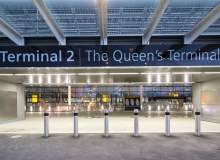

It was supposed to be a crowning moment for the UK’s hub airport, but turned into one of its darkest hours. London Heathrow’s Terminal 5, designed at a cost of £4.3bn to showcase the best of 21st century design and technology, is still working to distance itself from its disastrous opening in March 2008.
In almost every respect, T5’s launch transformed from a high-profile debut into a comprehensive guide on how not to open a terminal. Dozens of cancelled flights, a glitch in the baggage system that left a backlog of 15,000 bags and woefully inadequate staff training exacerbated by the logistical chaos that met workers simply trying to reach their stations – it soon became clear that the pristine terminal simply wasn’t prepared for the reality of serving passengers in any significant numbers.
The 2008 launch was described by Conservative leader David Cameron – not yet in power – as "humiliating", and the disaster even prompted the GMB union to plead with furious passengers about appropriate levels of vitriol to throw at hapless staff members.
T2: The Queen’s Terminal
The series of embarrassing blunders that constituted the T5 launch is a memory that Heathrow executives will have been keen to put behind them, especially in the run-up to the airport’s most recent high-profile launch – Terminal 2, dubbed The Queen’s Terminal. The new terminal, designed by Luis Vidal + Architects, is intended as a cutting-edge replacement of the old T2 building, Heathrow’s first passenger terminal, which gradually faded into decrepitude before its eventual closure in 2009.
With a price tag of around $2.5bn and its position as a core component of Heathrow’s contentious expansion programme, T2’s opening to passengers at the beginning of June marked another major test for the airport. And this time, the need to impress stretched right up to royalty, with Queen Elizabeth II and the Duke of Edinburgh attending the official opening ceremonies on 24 June.
Six years on, the lessons learned from the T5 debacle have come to define the airport’s approach for the T2 launch, which has adopted a softly-softly staged opening that has announced itself with more of a whisper than a bang, despite the dash of royal glamour sprinkled over the opening day.
Passenger choice is key to consumer spending at airports.
A smooth, staggered opening
At almost every stage leading up to T2’s launch, ‘caution’ has been the watchword. From a PR perspective, Heathrow bosses were quick to stress that teething problems were a high risk for the opening, a stark contrast to British Airways’ "bring it on" bluster in the run-up to T5’s opening. Even in the celebratory announcement of T2’s launch in June, Heathrow’s brand-new chief executive John Holland-Kaye remained guarded.
"Our measure of success is not everything running perfectly on day one – there will inevitably be things we can improve," he said. "Our real measure of success is whether Terminal 2 comes to be rated by passengers as one of the world’s best airport terminals for years to come."
Lessons learned from T5’s chaotic launch have been taken to heart. "I actually carry a copy of the transport select committee report into the T5 debacle in my bag with me, to make sure we learn the lessons of last time round," Holland-Kaye said.
The primary end result of this learning process has been the separation of T2’s opening into manageable stages, allowing the terminal a gentle ramping-up rather than having to hit the ground at a full sprint. The terminal opened with United Airlines as its sole occupant on 4 June, joined by Air Canada, Air China and ANA on 18 June and EVA Air on 2 July as operations gradually gather pace. All of the terminal’s airlines are planned to be in place by the end of October 2014.
Another important lesson learned by T2’s planners is the value of testing every inch of the building’s moving parts, over and over again. Heathrow mustered a battalion of volunteers, 14,000 all told, to put T2’s equipment, passenger flow and wayfinding through their paces over the course of 180 separate trials. The terminal’s intricate luggage system, a major stumbling block for T5, has been a particular focus for testing, with 100,000 bags moved through the system before building’s doors opened for the public.
Responding to problems
With such a conservative flight schedule and testing procedures as extensive as these, it’s little surprise that there have been few hiccups, and certainly none on the scale of T5. Several airline additions, including Thai Airways and Turkish Airlines, have been postponed due to, of all things, issues with the baggage system.
But according to Holland-Kaye, these postponements have all been covered by the contingency plan. As he told UK newspaper The Independent at the beginning of July: "It was always planned that we would bring forward or hold back airline moves depending on how Terminal 2 was working."
The slow, steady nature of Heathrow’s T2 debut has left it open to accusations of under-ambition that might sting for the terminal’s early business. All those flagship restaurants and shops, for example, will likely need to wait until well after the summer before they get enough footfall to turn a decent profit. Still, it’s difficult to blame a company for emphatically applying lessons learned from one of the biggest failures in its history, and the staggered start has given the airport time to respond to issues without inconveniencing passengers.
Terminal 5, meanwhile, is still having trouble with baggage, with thousands of British Airways passengers recently separated from their luggage after repeated IT faults. T5’s role as a cautionary tale for all of Heathrow’s future endeavours looks set to continue for some time yet.



